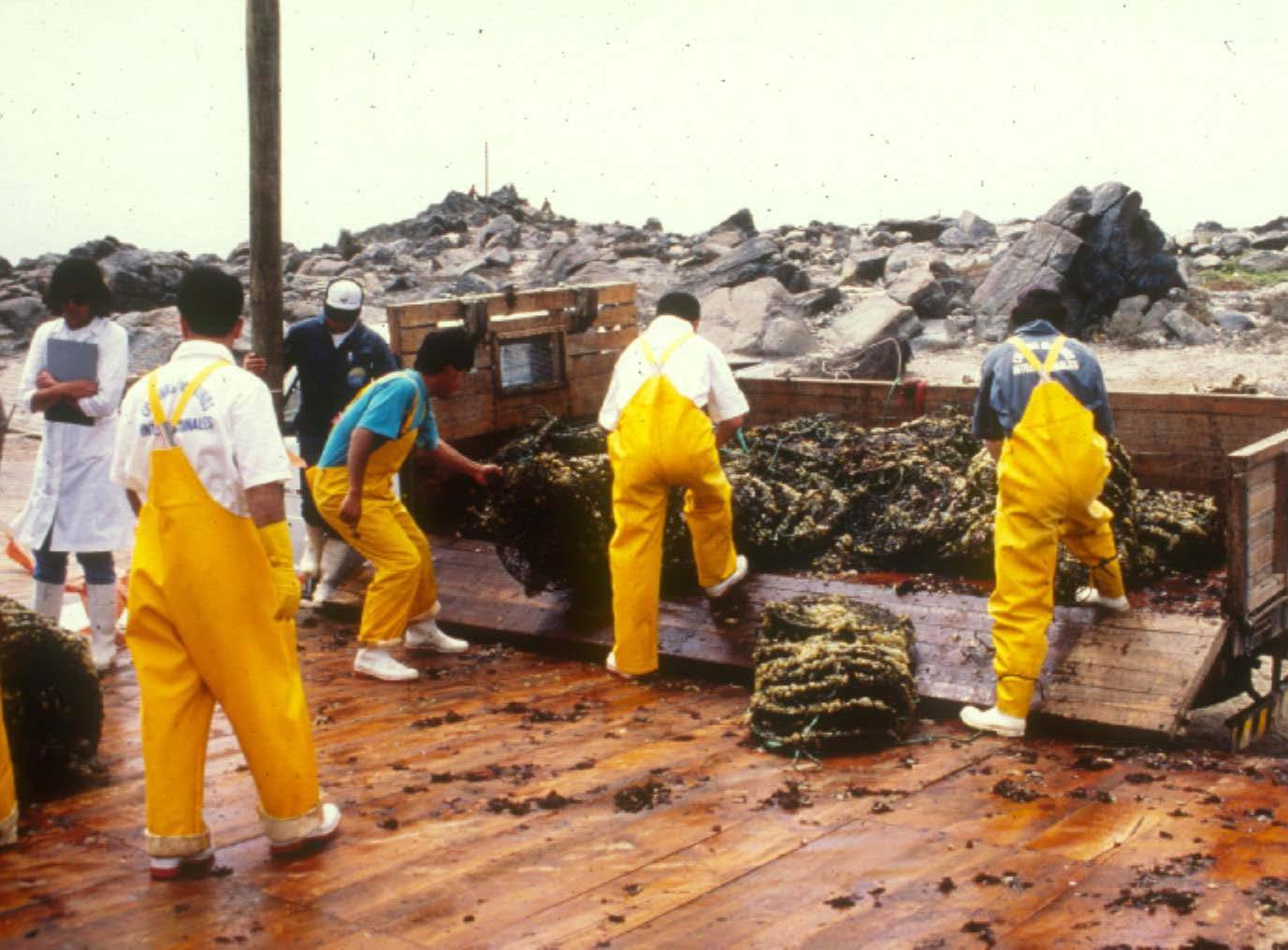6 minute read
THE SHELLFISH CORNER
Controlling Biofouling on Shellfish and Gear
By Michael A. Rice*
Biofouling is a complex and costly problem in most shellfish aquaculture operations. Problem areas include fouling on gear such as cages, mesh bags, predator control netting that may impede proper water flow to the shellfish stock, resulting in reduced food supply, and ultimately, growth stunting of the shellfish stock. Estimates of the effect of not properly managing biofouling on shellfish aquaculture gear suggest that it can reduce growth rates in oysters in excess of 40%.
Any aquaculture gear or shellfish stock placed into marine environments rapidly becomes colonized by biofouling organisms. In very short order upon immersion, surfaces become primed for colonization by chemical adhesion or adsorption of proteins and other dissolved organic material (DOM) present in the water, and these chemically prepared surfaces allow for bacterial colonization within a few hours, followed by unicellular microalgae, protozoans, and fungi. These earliest colonizing organisms form a slimy surface referred to as a biofilm or microfouling. Finally macrofouling invertebrates such as barnacles, mussels, and ascidians begun to cover the surfaces along with macroalgae or seaweeds. Biofouling is a complex and costly problem in most shellfish aquaculture operations, often significantly cutting into profit margins.
The specific types and the intensity of biofouling in shellfish farms are very site-specific, depending on local environment, season and yearto year climate variables. Problem areas include fouling on gear such as cages, mesh bags, predator control netting that may impede proper water flow to the shellfish stock, resulting in reduced food supply, and ultimately, growth stunting of the shellfish stock. Estimates of the effect of not properly managing biofouling on shellfish aquaculture gear suggest that it can reduce growth rates in oysters in excess of 40 percent [See: Hidu et al. 1981. Aquaculture 22:189-192]. A survey of shellfish farmers across the United States showed that 14.7% of shellfish farm operating costs, amounting to over US$ 21 million annually [See: Adams et al. 2011. J. World Aquaculture Soc. 42:242-252]. Biofouling of floats and gear suspension lines can add considerable weight, causing gear to sink or make overall gear handling more difficult. Fouling of the shellfish stock itself can create additional problems. Biofouling can not only impede the growth of the shellfish, but also affect its marketability as well. For instance, oysters encrusted with barnacles may not be as aesthetically pleasing for sale in the half-shell trade, and other biofouling invertebrates such as boring sponges and mud blister worms (an annelid worm boring into shells) can weaken the shells, making shucking very difficult without breakage.
The most common method to control biofouling around shellfish farms is by some form of mechanical cleaning, such as use of brushing, scraping, or use of powered water spraying [See: Hodson et al. 1997. Aquaculture 152:77-90]. However, a drawback to power washing of gear is in some coastal areas is that farm neighbors object to the noise generated by the machine. Often air/ sun drying of gear can aid in the cleaning by killing and drying out some of the biofouling organisms, making their mechanical removal easier. Cleaning of shellfish or gear can be combined with dips into fresh water, high salinity brine, acetic acid (vinegar) or chlorine bleach for varying lengths of time to aid in killing the biofouling organisms as well [see: Carver et al. 2003. J. Shellfish Res. 22:621-631]. The use of some biocidal chemical coatings such as copper oxide and tributyl tin on gear has been used as a means to avoid more labor-intensive approaches, but this approach has been banned in many jurisdictions based upon demonstrated negative consequences on local habitats and additional regulatory concern for human health [See: Guardiola et al. 2012. Int. J. Molecular Sci. 13:1541- 1560 for an excellent review].
A number of alternative methods have been developed, such as the use of grazing fish or sea ur-
chins in conjunction with shellfish farming, as a means to control biofouling, particularly macroalgae [See: Hasse 1974. Prog. Fish Culturist 36:160-162; Lodieros & Garcia 2004. Aquaculture 231:293-298]. Local knowledge of specific areas and past occurrences of the timing of previous biofouling episodes can be used to develop strategies for moving gear temporarily to other locations to avoid a future fouling event.
In more recent times the use of silicone or other smooth surface plastic coatings for gear to resist development of initial bacterial or algal biofilms, or allow for easy release of freshly set biofouling organisms, have been developed or are under development. Current research on biofouling prevention is focusing upon the surface properties of materials and their ability to attract or resist biofouling organisms. The four key properties of material surfaces affecting biofouling settlement include, the mechanical properties such as coefficient of
Biofouling of oyster bags in Point Judith Pond, Rhode Island. Photo by the author.
Biofouling of floats and gear suspension lines can add considerable weight, causing gear to sink or make overall gear handling more difficult.


Local knowledge of specific areas and past occurrences of the timing of previous biofouling episodes can be used to develop strategies for moving gear temporarily to other locations to avoid a future fouling event.
Biofouled mussel spat collector line in the Black Sea near Batumi, Georgia. Photo by the author.
friction (or slipperiness); structural properties such as porosity and topology (shapes, roughness and degree of regularity of geometric forms on the surface); polarity (nature of electrical charges on the surface); and the surface chemistry, including the bioactivity of exposed molecular groups once exposed to seawater. Materials science studies of this type are expected to point the direction to better biofouling technologies for the aquaculture industry. Promising new coatings with a high degree of resistance to biofouling are now under development, but all too frequently once exposed to real world conditions they fail to perform as they do in the laboratory [See: Koc et al. 2019. J. Bioadhesion & Biofilm Res. 35:454-462].
One interesting recent practical development in the control of biofouling on cultured shellfish themselves is the use of wax-based coatings applied to pearl oysters during the high season for biofouling in China. In the study, pearl oysters (Pinctada imbricata) were coated with a thin layer of paraffin wax, or alternatively the wax infused with Chinaberry seed extract or honeylocust seed extracts, and then tested against untreated control oysters at coastal pearl farm sites. The wax-based coatings deterred fouling-organism settlement on oysters for at least 60 days during the intensive fouling season, while reducing mortality and not adversely affecting their growth [See: Ye et al. 2019. J. Bioadhesion & Biofilm Res. 35:649-657]. Since there are a number of food-grade waxes and similar coatings approved by food safety authorities such as the Food and Drug Administration (FDA) in the United States for use as coating of fruits destined for human consumption, this approach of applied wax coatings might be adapted for use in aquaculture production of shellfish destined for human consumption. One obvious application of this technology may be for trials with oysters to prevent biofouling by boring sponges or mud blisters that frustrate many oyster farmers in the Northeastern United States.
Michael A. Rice, PhD, is a Professor of Fisheries, Animal and Veterinary Science at the University of Rhode Island. He has published extensively in the areas of physiological ecology of mollusks, shellfishery management, molluscan aquaculture, and aquaculture in international development. He has served as Chairperson of his department at the University of Rhode Island, and as an elected member of the Rhode Island House of Representatives. rice@uri.edu


